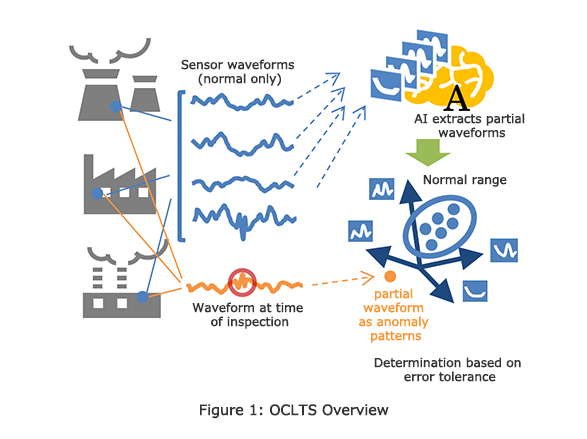Toshiba's Highly Explanatory AI Uses Normal Waveform Data to Learn and Detect Equipment Anomalies
-improves utilization rates of factory and social infrastructure plant and reduce maintenance costs-
Toshiba Corporation
TOKYO─Toshiba Corporation (TOKYO: 6502) has applied machine learning (AI) to the problem of detecting anomalies that cause downtime in manufacturing facilities and social infrastructure, and developed a system, "One-Class Learning Time-series Shapelets (OCLTS)," that is 9% more accurate than current approaches and that provides a firm basis for identifying potential problems. OCLTS will improve the accuracy of anomaly detection in industrial equipment, and provide an explanatory basis for determining causes. Once deployed, it will contribute to higher equipment utilization rates and lower maintenance costs.
OCLTS constructs anomaly detection models using only normal time-series data collected from numerous sensors installed in equipment. It is highly accurate, and can detect rare and even unknown anomalies. By developing a technology able to extract partial waveform patterns that occur repeatedly in normal operating conditions (normal waveform patterns), and detecting anomalies based on differences from those patterns, Toshiba has also succeeded in realizing a highly explanatory system that provides a sound basis for determining equipment anomalies.
Toshiba announced the details of OCLTS at the IEEE International Conference on BIG DATA 2018 in Seattle, USA(Note 1).
With the recent expansion of industrial IoT, increasing numbers of devices and equipment are connected to the Internet, creating environments where large volumes of time-series data can be collected. This also creates an opportunity, as applying machine learning to analysis of that data meets the need for an anomaly detection technology that can be used in factories and social infrastructure sites to determine whether equipment is running normally or abnormally with high accuracy.
One drawback with this approach is that anomalies occur infrequently in much of the equipment that can be analyzed with waveform data. Without enough samples of anomaly data for machine learning to improve the accuracy of detection, the results will be insufficient. Also, when an anomaly occurs, site engineers often investigate the cause and devise countermeasures, and they are required to show the grounds on which the AI determined there was an anomaly.
In operation, OCLTS first automatically learns multiple time series segments that are representative of normal waveform patterns, known in AI as shapelets. The normal range derived from the shapelets is then compared with waveform data extracted during inspections, and if there is a deviation from the normal range, the AI determines an equipment anomaly. This approach allows the AI to detect anomalies it has not experienced; and based on when the difference appears in the comparison of the waveforms, and from its size and shape, it becomes possible to link the data to initiating an investigation into the cause of the anomaly.
OCLTS offers other advantages. By learning the One-Class Support Vector Machine (OCSVM)(Note 2) classification of normal and abnormal states, it can be applied even when classification boundaries are complex. Speeding up the learning algorithm reduces the computational complexity required from the quadratic time-series length to the linear time series length, realizing AI that can scale to the time-series length. In performance verification based on published time series benchmark data, Toshiba confirmed that OCLTS has a 9% in accuracy over current shapelet-based technologies.
Toshiba Group is developing technologies and know-how that will support its digital transformation and transition to become one of the world's leading cyber-physical systems (CPS) technology companies. OCLTS and other advances in AI and digital technologies will support it in achieving these goals. Going forward, Toshiba will direct its energy into refining the classification accuracy of OCLTS, confirm its effectiveness for a wider range time series data, and ultimately apply it the monitoring of industrial plant and equipment and social infrastructure.
Using only normal sensor waveforms of time series data collected from industrial equipment, such as manufacturing machinery, OCLTS’s AI extracts partial waveforms and learns the normal range. When it detects a sensor waveform outside the normal range, it determines an anomaly.

- (Note 1)
- In addition to the IEEE presentation, this technology was also covered by the International Journal of Data Mining Science.
- (Note 2)
- An existing technology that learns the normal range only from normal data based on non-time series data (non-waveform data).


